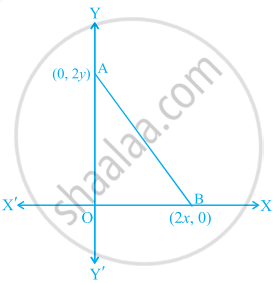Advertisements
Advertisements
Question
Find x if distance between points L(x, 7) and M(1, 15) is 10.
Solution 1
L(x, 7), M(1, 15), and LM = 10.
By distance formula,
∴ LM = `sqrt((x − 1)^2 + (7 − 15)^2)`
∴ 10 = `sqrt((x - 1)^2 + (− 8)^2)`
Squaring both the sides, we get,
∴ 100 = (x − 1)2 + 64
∴ (x − 1)2 = 100 − 64
∴ (x − 1)2 = 36
Taking square roots of both the sides,
∴ x − 1 = `+-` 6
∴ x − 1 = 6 or x - 1 = −6
∴ x = 6 + 1 or x = −6 + 1
∴ x = 7 or x = −5
x = 7 or x = −5
Solution 2
L(x, 7), M(1, 15), and LM = 10.
By distance formula,
∴ LM = `sqrt((x − 1)^2 + (7 − 15)^2)`
∴ 10 = `sqrt((x - 1)^2 + (− 8)^2)`
Squaring both the sides, we get,
∴ 100 = (x − 1)2 + 64
∴ 100 = x2 − 2x + 1 + 64
∴ 100 = x2 − 2x + 65
∴ x2 − 2x + 65 − 100 = 0
∴ x2 − 2x − 35 = 0
∴ x2 − 7x + 5x - 35 = 0
∴ x(x − 7) + 5(x − 7) = 0
∴ (x − 7)(x + 5) = 0
∴ x − 7 = 0 or x + 5 = 0
∴ x = 7 or x = −5
x = 7 or x = −5
APPEARS IN
RELATED QUESTIONS
If the point A(0, 2) is equidistant from the points B(3, p) and C(p, 5), find p. Also, find the length of AB.
If the opposite vertices of a square are (1, – 1) and (3, 4), find the coordinates of the remaining angular points.
Find the value of a when the distance between the points (3, a) and (4, 1) is `sqrt10`
Show that the quadrilateral whose vertices are (2, −1), (3, 4) (−2, 3) and (−3,−2) is a rhombus.
If the point A(x,2) is equidistant form the points B(8,-2) and C(2,-2) , find the value of x. Also, find the value of x . Also, find the length of AB.
Using the distance formula, show that the given points are collinear:
(-1, -1), (2, 3) and (8, 11)
`" Find the distance between the points" A ((-8)/5,2) and B (2/5,2)`
Find the distance between the following pair of point in the coordinate plane :
(5 , -2) and (1 , 5)
Find the point on the x-axis equidistant from the points (5,4) and (-2,3).
Prove that the following set of point is collinear :
(4, -5),(1 , 1),(-2 , 7)
Prove that the points (a, b), (a + 3, b + 4), (a − 1, b + 7) and (a − 4, b + 3) are the vertices of a parallelogram.
Find the distance between the origin and the point:
(-5, -12)
Show that the points P (0, 5), Q (5, 10) and R (6, 3) are the vertices of an isosceles triangle.
Find distance between point A(– 3, 4) and origin O
Find distance CD where C(– 3a, a), D(a, – 2a)
Show that P(– 2, 2), Q(2, 2) and R(2, 7) are vertices of a right angled triangle
The coordinates of the point which is equidistant from the three vertices of the ΔAOB as shown in the figure is ______.

The distance between the point P(1, 4) and Q(4, 0) is ______.
What is the distance of the point (– 5, 4) from the origin?
The distance of the point (5, 0) from the origin is ______.
